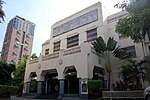De La Salle–College of Saint Benilde (Filipino: Dalubhasaan ng De La Salle San Benildo; French: Collège De La Salle de Sainte Benilde), also known as DLS-CSB or Benilde, is a private, Catholic secondary and tertiary education institution established by De La Salle Brothers located in Malate district of Manila, Philippines. It operates four campuses all of which are located within the vicinity of Malate, Manila. The college is a member institution of De La Salle Philippines (DLSP), a network of 16 Catholic Lasallian institutions. Benilde is also a member of a 350-year-old international network of over 1,200 Lasallian educational institutions globally established by the De La Salle Christian Brothers in 82 countries.The college was established in 1980 during the administration of Br. Andrew Gonzalez, FSC as the College of Career Development, a night school for working students at De La Salle University-Manila. In 1988, it was renamed the De La Salle University–College of Saint Benilde after the Vatican's Patron Saint of Vocations – Saint Bénilde Romançon, a Christian Brother who taught in France during the 19th century. In 1994, the college became autonomous. In 2004, along with a restated vision and mission, received its present name, dropping the University and becoming De La Salle–College of Saint Benilde.
The college uses "learner-centered instruction" to offer degree and non-degree programs in the arts, design, management, service industries, computer applications in business, and special fields of study. It is the first in the Philippines to offer degrees in AB Animation, AB Film, AB Production Design, AB Multimedia Arts, AB Fashion Design and Merchandising, BPA Dance and AB Photography.The college's sports teams, known as the Saint Benilde Blazers, compete in the National Collegiate Athletic Association with La Salle Green Hills representing the junior division. Since joining the league in 1998, the college has won five general championships, first in the 2005 season, back-to-back in the 2007 and 2008 seasons and another back-to-back win in 2013 and 2014 seasons.








